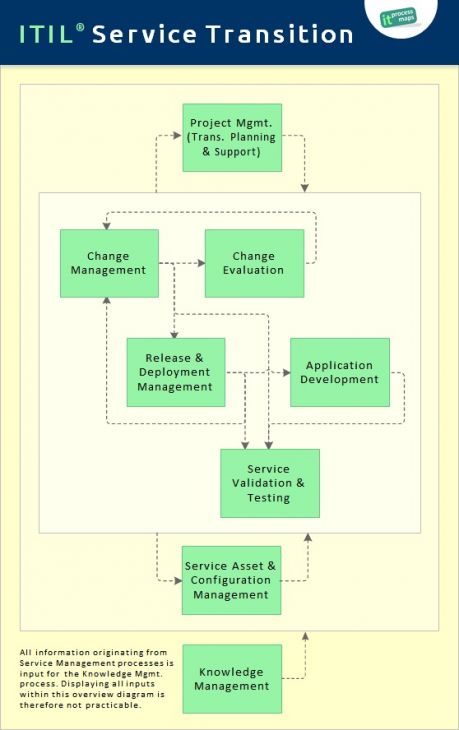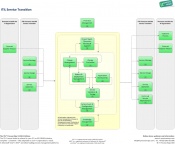ITIL Service Transition: Difference between revisions
No edit summary |
|||
| Line 20: | Line 20: | ||
<imagemap> | <imagemap> | ||
Image:Overview_service_transition_itilv3.jpg||left|ITIL Service Transition - Click on a process for more details|459px|thumb|alt=ITIL Service Transition | Image:Overview_service_transition_itilv3.jpg||left|ITIL Service Transition - Click on a process for more details|459px|thumb|alt=ITIL Service Transition | ||
rect | rect 179 99 280 169 [[Project Management - Transition Planning and Support|Project Management (Transition Planning and Support) - Service Transition]] | ||
rect | rect 55 224 155 294 [[Change Management|Change Management - Service Transition]] | ||
rect | rect 203 224 303 292 [[ITIL Change Evaluation|Change Evaluation - Service Transition]] | ||
rect | rect 119 333 220 404 [[Release and Deployment Management|Release and Deployment Management - Service Transition]] | ||
rect | rect 289 333 390 401 [[Application Development and Customization|Application Development - Service Transition]] | ||
rect | rect 217 443 318 514 [[Service Validation and Testing|Service Validation and Testing - Service Transition]] | ||
rect | rect 180 545 282 615 [[Service Asset and Configuration Management|Service Asset and Configuration Management - Service Transition]] | ||
rect 179 646 280 717 [[Knowledge Management|Knowledge Management - Service Transition]] | |||
desc bottom-left | desc bottom-left | ||
</imagemap> | </imagemap> | ||
The following processes are part of the ITIL | The following processes are part of the ITIL stage [[ITIL V3 Service Transition|Service Transition]]: | ||
<p> </p> | <p> </p> | ||
| Line 43: | Line 44: | ||
:Process Objective: To plan and coordinate the resources to deploy a major Release within the predicted cost, time and quality estimates. | :Process Objective: To plan and coordinate the resources to deploy a major Release within the predicted cost, time and quality estimates. | ||
;[[Application Development and Customization]] | ;[[Application Development and Customization|Application Development]] | ||
:Process Objective: To make available applications and systems which provide the required functionality for IT services. This process includes the development and maintenance of custom applications as well as the customization of products from software vendors. | :Process Objective: To make available applications and systems which provide the required functionality for IT services. This process includes the development and maintenance of custom applications as well as the customization of products from software vendors. | ||
| Line 59: | Line 60: | ||
<p> </p> | <p> </p> | ||
<br style="clear:both;"/> | |||
== Additional Information on Service Transition == | == Additional Information on Service Transition == | ||
| Line 70: | Line 72: | ||
== Downloads == | == Downloads == | ||
==== Overview Service Transition | ==== Overview Service Transition ==== | ||
{| | {| | ||
| Line 82: | Line 84: | ||
|- | |- | ||
|} | |} | ||
<!-- This page is assigned to the following categories: --> | <!-- This page is assigned to the following categories: --> | ||
[[Category:ITIL V3]][[Category:ITIL stage]][[Category:ITIL process|3]][[Category:Service Transition|!]] | [[Category:ITIL V3]][[Category:ITIL 2011]][[Category:ITIL stage]][[Category:ITIL process|3]][[Category:Service Transition|!]] | ||
<!-- --- --> | <!-- --- --> | ||
Revision as of 15:15, 18 November 2011
<seo metakeywords="service transition, itil service transition, itil transition, itil v3 transition, itil v3 service transition" metadescription="ITIL Service Transition: Definition - Processes - Additional information on Service Transition: ITIL Roles, Checklists, KPIs..." />

ITIL Service Transition
The objective of ITIL Service Transition is to build and deploy IT services. Service Transition also makes sure that changes to services and Service Management processes are carried out in a coordinated way.
Part of: IT Service Management
Processes: ITIL Service Transition

The following processes are part of the ITIL stage Service Transition:
- Change Management
- Process Objective: To control the lifecycle of all Changes. The primary objective of Change Management is to enable beneficial Changes to be made, with minimum disruption to IT services.
- Change Evaluation
- Process Objective: To assess major Changes, like the introduction of a new service or a substantial change to an existing service, before those Changes are allowed to proceed to the next phase in their lifecycle.
- Project Management (Transition Planning and Support)
- Process Objective: To plan and coordinate the resources to deploy a major Release within the predicted cost, time and quality estimates.
- Application Development
- Process Objective: To make available applications and systems which provide the required functionality for IT services. This process includes the development and maintenance of custom applications as well as the customization of products from software vendors.
- Release and Deployment Management
- Process Objective: To plan, schedule and control the movement of releases to test and live environments. The primary goal of Release Management is to ensure that the integrity of the live environment is protected and that the correct components are released.
- Service Validation and Testing
- Process Objective: To ensure that deployed Releases and the resulting services meet customer expectations, and to verify that IT operations is able to support the new service.
- Service Asset and Configuration Management
- Process Objective: To maintain information about Configuration Items required to deliver an IT service, including their relationships.
- Knowledge Management
- Process Objective: To gather, analyze, store and share knowledge and information within the organization. The primary purpose of Knowledge Management is to improve efficiency by reducing the need to rediscover knowledge.
Additional Information on Service Transition
Downloads
Overview Service Transition
|
Use the following links to open the process overview of Service Transition showing the most important interfaces: |
 |






